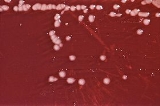
Pseudomonas
Overview
Genus
In biology, a genus is a low-level taxonomic rank used in the biological classification of living and fossil organisms, which is an example of definition by genus and differentia...
of gammaproteobacteria
Gammaproteobacteria
Gammaproteobacteria is a class of several medically, ecologically and scientifically important groups of bacteria, such as the Enterobacteriaceae , Vibrionaceae and Pseudomonadaceae. An exceeding number of important pathogens belongs to this class, e.g...
, belonging to the family Pseudomonadaceae
Pseudomonadaceae
The Pseudomonadaceae is a family of bacteria that includes the genera Azomonas, Azomonotrichon, Azorhizophilus, Azotobacter, Cellvibrio, Mesophilobacter, Pseudomonas , Rhizobacter, Rugamonas, and Serpens...
containing 191 validly described species.
Recently, 16S rRNA
16S ribosomal RNA
16S ribosomal RNA is a component of the 30S subunit of prokaryotic ribosomes. It is approximately 1.5kb in length...
sequence analysis has redefined the taxonomy of many bacterial species. As a result, the genus Pseudomonas includes strains formerly classified in the genera Chryseomonas and Flavimonas. Other strains previously classified in the genus Pseudomonas are now classified in the genera Burkholderia
Burkholderia
Burkholderia is a genus of proteobacteria probably best known for its pathogenic members:Burkholderia mallei, responsible for glanders, a disease that occurs mostly in horses and related animals;...
and Ralstonia
Ralstonia
Ralstonia is a genus of proteobacteria, previously included in the genus Pseudomonas. It is named after the American bacteriologist E. Ralston.-Genomics:* *...
.
Like most bacteria genera the pseudomonad last common ancestor lived hundreds of million years ago, however they were classified by humans at the end of the 19th century.
Because of their widespread occurrence in water and in plant seeds such as dicots, the pseudomonads were observed early in the history of microbiology
Microbiology
Microbiology is the study of microorganisms, which are defined as any microscopic organism that comprises either a single cell , cell clusters or no cell at all . This includes eukaryotes, such as fungi and protists, and prokaryotes...
.
Unanswered Questions

